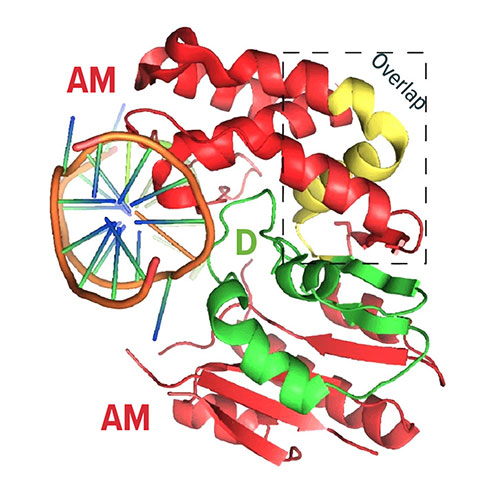SPDamID: When Two Halves Make More Than a Whole
Research By: Raphael Kopan, PhD
Post Date: June 28, 2019 | Publish Date: Aug. 6, 2015

New SpDamID tool opens doors for studying how pairs of transcription factors affect development and disease. Think of this innovation as replacing a hammer and chisel with a power drill.

Thanks to a breakthrough reported earlier this year at Cincinnati Children’s, scientists worldwide have a new tool at their disposal for studying the inner workings of how tissues form and diseases begin. This tool, known as SpDamID, makes it easier and faster to gather data on the complex roles that transcription factors can play in regulating cellular processes.
Eventually, new understandings generated by the data could lead to breakthroughs in areas ranging from kidney disease to plant biology.
A team led by Matthew Hass, PhD, and Raphael Kopan, PhD, director of Developmental Biology, developed the new tool. They described their discovery in a paper appearing Aug. 6, 2015, in Molecular Cell. Ever since, the team has been fielding requests from other scientists interested in putting SpDamID to work in their labs.
“With further development, this technology has the potential to give investigators glimpses into biological problems that cannot be answered with existing tools,” Kopan says. “This method has been transformative for our research.”
Discovery Born of Frustration
Scientists have long understood that transcription factors play vital roles in regulating cellular processes. As these proteins bind to chromosomal sites, they deliver instructions that direct a cell’s fate and function. When the instructions flow normally, cells perform their intended duties. When malfunctions occur, disease can begin.
However, drilling down to the cellular level to measure how transcription factors interact—in what order, over time—has been a technical challenge.
In recent years, developmental biologists have gathered rough snapshots of protein activity by using a combination of chromatin immunoprecipitation and next-generation gene sequencing (ChIP-seq). However, the process is tedious and requires material from up to one million cells to produce results.
Even so, this approach fails to deliver a conclusive picture.
“Using the older method, we can infer that two proteins might have a relationship because we can see that they bind to DNA at nearby locations,” Kopan says. “But we cannot see whether the two proteins are binding at the same time, or even within the same cell. So we cannot be confident that an actual relationship exists.”
Notch Knowledge
The new SpDamID tool builds from nearly two decades of study in Kopan’s lab to explore Notch, a critical molecule involved in tissue and organ development. When switched on, Notch binds to DNA—but only after linking first to a DNA-binding partner.
The new tool exploits this partnership process. Led by Hass, lab staff began splitting a well-known enzyme called DNA adenine methyltransferase (DAM). They connected one inactive half of DAM to one protein of interest, and the other half to another protein of interest.
Whenever the targeted proteins bind to DNA while in close proximity, or even when the proteins bind directly to each other, the reconnected DAM enzyme becomes active. This allows experts to mark each chromosome location where the two proteins interact.
This reaction occurs only when both proteins are active in the same cell and on the same strand of DNA. This eliminates nearly all the ambiguity from other methods over whether a relationship exists. The test also produces results from samples with as few as 10 cells.
Exploring Applications
In Kopan’s lab, the SpDamID tool already has detected an interesting relationship between Notch and the transcription factor Runx1, which could have implications for kidney development. The tool may also prove useful in exploring cancer, multiple sclerosis and other conditions.
Kopan has even been contacted by a plant biologist looking for an alternative to ChIP-seq.
So far, the team has fused the halves of SpDamID to 30 different transcription factor proteins, and documented the outcomes. Eventually, they hope to build a data library that covers all 1,400 known transcription factors.
While the new tool has a variety of potential uses, Kopan declines to speculate on the longer-term impact of SpDamID.
“We hope it will help a broad range of scientists,” he says. “But its value will last only until the next new tool comes along.”
| Original title: | SpDamID: Marking DNA Bound by Protein Complexes Identifies Notch-Dimer Responsive Enhancers |
| Published in: | Molecular Cell |
| Publish date: | Aug. 6, 2015 |
Research By





